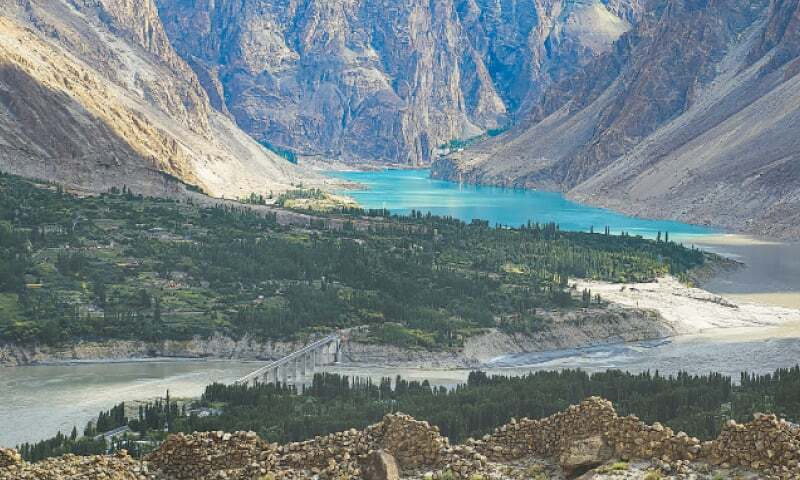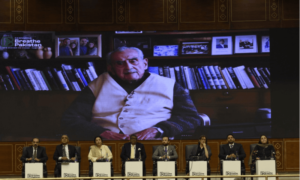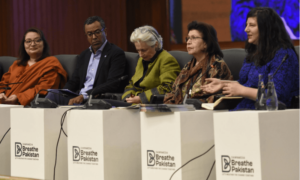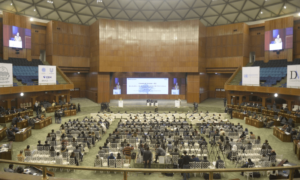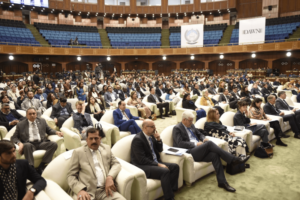AS the industrialized world grapples with fulfilling its commitments to fund the climate-related losses and damages they have caused, South Asian nations must take proactive leadership in shaping their own climate resilience and drive innovative solutions.
Climate change knows no borders. While South Asian nations sometimes stand divided, they are all confronted with the same challenge.
As temperatures rise, climate-induced disasters are becoming more frequent and intense, inflicting immense and disproportionate costs on the lives of all people, especially the poorest. Sea-level rise, glacial melt, heatwaves, droughts and disastrous floods compound existing vulnerabilities, further compromising livelihoods and food security, and access to water and other basic services.
At the same time, the region continues to grapple with significant pollution challenges, from domestic sources, underscoring the need for cross-border collaboration to deal with environmental challenges.
Meanwhile the world’s biggest polluters remain reluctant to accept responsibility for the damage they have caused. In 2023, industrialized nations pledged just $700 million of the $400 billion that lower-income countries estimate they need by 2030 less than 0.2pc.
Much of the climate finance the industrialised world has extended takes the form of loans. This further increases the debt burden for many South Asian nations, particularly Pakistan.
Trapped in a web of debt, climate vulnerability, and under-investment in human development, they strive to adapt to the changing climate and its social, economic and humanitarian impacts. They need to overcome these enormous challenges if they want to achieve sustainable development and improve the living standards of their peoples.
Every dollar allocated to debt repayment is a dollar denied to building hospitals and schools, improving access to essential services, and adapting to the impacts of climate change.
These issues are critical not only to human development, but also to future economic growth and prosperity of the entire region. Without alternative sources of finance, many of the South Asian countries will not be able to achieve the 17 Sustainable Development Goals (SDGs) by their 2030 deadline.
Suspending The Debt
In the face of the SDG financing gap, we need to consider new options. A standstill on governments’ external debt repayments until 2030 could provide a solution. In Pakistan, it would free up an estimated $108 billion, providing fiscal breathing room that would enable the country to focus on meeting the SDGs deadline.
It would help lift people out of poverty; reduce maternal, newborn and child mortality, improve enrollment in schools; and improve climate resilience. Even a simple break on interest payments could help.
In September, countries around the world agreed to the United Nations’ ‘Pact for the Future’. This document contains important commitments on access to finance; effective action on debt; and substantially increasing the lending capacity of multilateral development banks.
It also aims at accelerating global action on climate change by emphasizing cooperative efforts to achieve the SDGs and the Paris Agreement that aims to reduce global greenhouse gas emissions and adapt to climate change.
The Pact for the Future provides a unique opportunity to align global priorities with the needs of vulnerable nations. It calls on mobilising resources comprehensively to galvanise progress towards achieving the SDGs in the six years we have left.
Failure is not an option. South Asia must lead. The need is urgent and the time is short, but the rewards will be great. The United Nations will support Pakistan and South Asia every step of the way.
What South Asia Can Do For Itself
While the world needs to continue pressing rich nations to deliver climate justice, it is time for South Asian countries to ask not only what the world can do for them, but also what they can do for themselves through collective action as a region.
Just last year, Bangladesh, India, Nepal, Pakistan, and Sri Lanka went through a record-breaking heatwave, causing widespread disruptions and casualties. Floods resulting from melting Himalayan glaciers also affected the region. Every year, climate change is increasing the frequency, duration, and intensity of extreme weather events.
We still have in mind the devastating floods that hit Pakistan in 2022, affecting at least 33 million people. As UN Secretary General António Guterres said at the time, the Pakistani people faced a monsoon on steroids — the relentless impact of epochal levels of rain and flooding. The climate catastrophe killed nearly 2,000 people with many more injured.
Millions were left homeless, schools and health facilities were destroyed, livelihoods shattered, critical infrastructure wiped out, and people’s hopes and dreams washed away. Last year again, the monsoon season in South Asia caused severe flooding in Bangladesh, India, Nepal and Pakistan.
South Asia also needs to turn the tide of environmental degradation. Every winter, the toxic smog that chokes people in Lahore also envelopes New Delhi.
People, including children, are forced to breathe the deadly polluted air unleashed by farmers burning agricultural waste, coal power plants, and exhaust gases.
This year again, air pollution levels broke records on both sides of the border in November, with an unprecedented intensification of the subcontinent’s annual smog wave. The air pollution was even visible from space — Nasa satellite imaging showed a continuous cloud of smog stretching from eastern and northern Pakistan, to northwestern India.
The Air Quality Index (AQI) in Lahore was 12 times above the level the World Health Organization (WHO) considers satisfactory for breathing. On Nov 7 last year, readings showed that the city briefly became the most polluted in the world.
Ten days later, it was New Delhi’s turn — with an AQI 15 times the level considered satisfactory for breathing, it also became one of the most polluted cities in the world.
In both countries, toxic particles created a regional public health crisis. Many people on both sides of the borders were hospitalized after suffering respiratory conditions that could be life-threatening, and particularly affected young children.
Today, both countries must urgently work on reducing emissions from agricultural, industrial and transportation activities, and promote clean and renewable energies.
The consequences of the climate and environmental challenges which South Asian nations face can only be lifted via cross-border collaboration.
It is time for South Asian governments and the region’s private sector leaders to come together and accelerate efforts toward building climate resilience, transitioning to low-carbon economies, protecting and restoring the environment, and transforming food systems for a sustainable future.
International Year Of Glaciers’ Preservation
South Asian nations share environmental challenges; they also share environmental assets — natural resources and ecosystems that support human life and are essential for economic development.
Think of the high peaks of South Asia, which stretch across several nations. They work as ‘water towers’ for the subcontinent and the rivers that flow downstream.
The governments of these nations are custodians of the future of billions of people across the region. Their role is crucial if we do not want to find ourselves in an unknown range of climate impact in a few decades, where we could be looking at no ice left in the high mountains.
Imagine South Asia without its glaciers! The only remaining source of water would be precipitations — mainly the rains which the monsoon brings, bearing in mind that its patterns have become increasingly unreliable over the past years.
At the COP29 climate conference last year, discussions begun among South Asian mountain nations on building an alliance along the lines of the Small Island Developing States (SIDs). This will help them raise global awareness on the unique impacts which climate change inflicts on high mountains.
The United Nations General Assembly has proclaimed 2025 as the International Year of Glaciers’ Preservation to raise awareness on the vital role glaciers, snow, and ice play in the climate system and water cycle, as well as the far-reaching impacts of rapid glacial melt.
This marks a crucial milestone in global efforts to protect these essential water towers that provide freshwater to over two billion people worldwide.
Numerous activities and events during the year will seek to raise global awareness and inspire action in South Asia and around the world to address the urgent challenges posed by accelerated glacier melting.
The Government of Pakistan has established itself as an important voice in global climate diplomacy, having successfully advocated for the creation of a global climate ‘Loss and Damage Fund’ at the COP27 Climate Conference two years ago.
This fund was created to respond to the loss and damage which affect climate-vulnerable developing countries. It is meant to cover both the economic and non-economic loss and damage associated with the adverse effects of climate change, including extreme weather events and slow onset events.
The Fund must now be fully funded and accessible to those it was set up to serve. As UN Secretary General António Guterres recently said, “Climate finance is not a hand-out. It is an investment against the devastation that unchecked climate chaos will inflict on us all.”
A ‘Living Indus’
Pakistan can continue leading by working to foster regional collaboration to reduce the impact of environmental degradation and extreme weather events. It must also focus on the country’s environmental, economic and cultural backbone — the Indus River Basin. It has sustained life in the region for over 5,000 years, from the civilizations of Harappa and Mohenjo Daro, to the present day.
Today, nine of Pakistan’s 10 biggest cities are located within its reach, and millions of lives and livelihoods depend on its waters. But the Indus Basin is facing devastating challenges due to unsustainable population growth, rapid urbanization and industrialization, environmental degradation, the unregulated utilization of resources, inefficient water use, and poverty, all of which are aggravated by climate change.
If we cannot keep global warming under the 1.5°C limit, the troubling scenario of a total glacial melt may turn into reality in the next 40 years. Pakistan would be left to manage an Indus whose waters would only be fed by unpredictable monsoon rains. Whether we can preserve the source of all sustenance to Pakistan will determine the country’s fate.
This is why the Government of Pakistan has earned global praise for its ‘Living Indus’ initiative, which was selected as one of the world’s ‘Restoration Flagship’ programmes by the UN Environment Programme (UNEP) last year.
This ambitious initiative, which the UN has supported from the start, aims at protecting and restoring the ecological health of the Indus River Basin. It includes 25 interventions aiming to reduce environmental degradation, improve climate change mitigation, accelerate climate action, and sustain livelihoods.
By prioritizing the Indus River System, the Government of Pakistan has sent a strong signal to the world. It has also sent a signal to the communities who live along its banks, and whom I have had the privilege of meeting during my first year in Pakistan.
Those who live at the foot of the Himalayan glaciers that provide the water from which life and civilization have sprung. Those who cultivate fields in the vast plains which the Indus irrigates, turning sand into arable land, and creating livelihoods. Those who protect the mangroves of the Indus Delta, which provides people and marine life with oxygen.
At the same time, Pakistan can deepen its climate change credibility through accelerating implementation of the National Adaptation Plan (NAP), which requires robust investment. Its goal is to foster social, economic, and environmental resilience in the face of climate change.
It provides excellent paths to deal with critical issues such as the water-agricultural nexus, the renewable natural capital, the need to invest in human capital, and the reduction of communities’ exposure to growing climate hazards.
Unrolling The Solutions
The solutions to climate change are already being unrolled. UN agencies in Pakistan are actively working with the government, civil society and local communities to combat climate change.
We help develop sustainable environmental policies; prevent natural disasters and mitigate their impact; build climate-resilient infrastructure and water systems; and deliver humanitarian and recovery assistance to affected communities.
We promote efficient, sustainable agricultural and fishing practices, and the development of food systems that can meet the needs of the most vulnerable populations before, during and in the aftermath of disaster.
We help restore ecosystems and biodiversity, conserve natural resources and promote their sustainable use, harvest and conserve water, reverse deforestation, revive wetlands, and protect biodiversity.
We support environmental sustainability in the industry, integrated waste management, the development of clean sustainable energies, the improvement of air quality, and the reduction of plastic pollution. We educate and mobilize people — in particular youth — on the need to protect the environment and take climate action.
Climate change is a national, regional and global emergency; so are the solutions. In a region where there are plenty of differences and disagreements, climate action has the power to foster meaningful cooperation.
South Asian nations are among the most climate-vulnerable countries globally, yet they possess significant potential to become global leaders in driving regional self-help environmental initiatives, such as reducing air pollution, promoting conservation, and fostering community adaptation.
This will give each government in the region the chance to reap benefits such as clean and cheap renewable energies that support sustainable development.
Failure is not an option. South Asia must lead. The need is urgent, the time is short, but the rewards will be great. The United Nations will support Pakistan and South Asia every step of the way. We will never give up.
The writer is the UN’s Resident & Humanitarian Coordinator in Pakistan.
- Desk Reporthttps://foresightmags.com/author/admin/

